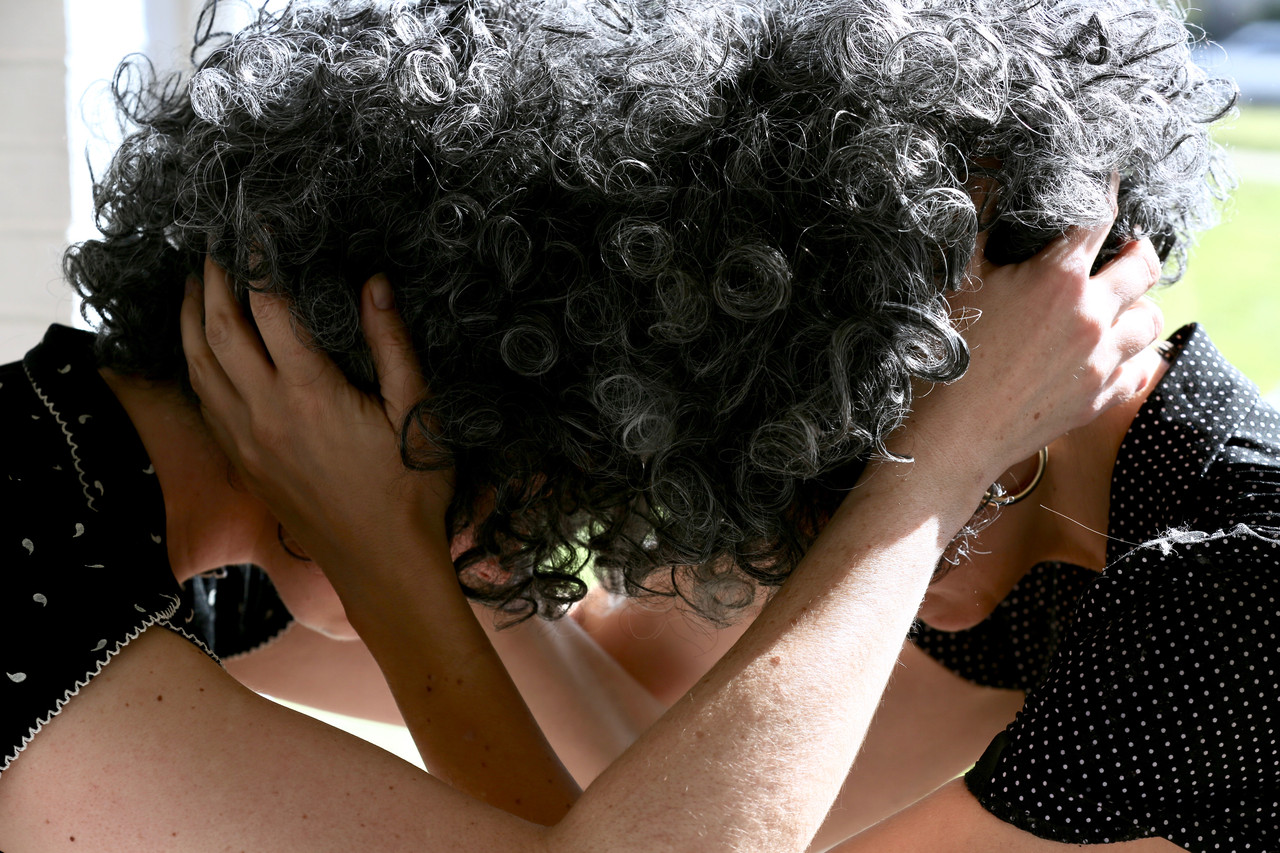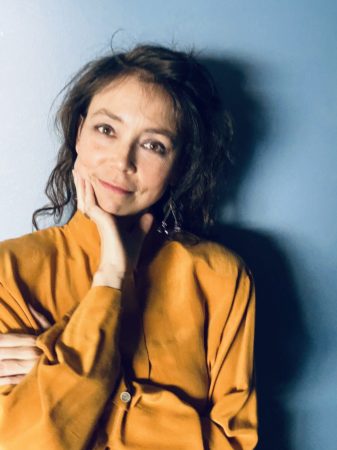Past Resident
Sarah Ledbetter

“Coming of age as a dance-maker, my goal is to deepen my commitment to the interpersonal nature of dance-making by including my audience in the creative community out of which the dance emerges. My aim in doing so is to bring the performance act back to its roots as an exchange between people who, together, seek a greater collective good.”
 Q&A with Sarah Ledbetter (from the Crosstown Arts newsletter, December 14, 2021)
Q&A with Sarah Ledbetter (from the Crosstown Arts newsletter, December 14, 2021)
Former Crosstown Arts resident artist Sarah B. Ledbetter is a dancing writer and a writing dancer whose work for screen, stage, and page has been presented nationally and internationally.
Recent publications and presentations include Floromancy, Poetry Superhighway, Right Hand Pointing, Fourth River, and R and R Literary Journal. Sarah recently presented at the Delicious Arts Residency Performer Showcase and was a featured teaching artist for New Dialect Dance. She’s currently at work on her first collection as well as a site-specific dance about female solitude.
Crosstown Arts registrar Jesse Butcher caught up with Sarah to discuss her artistic process and the work she created during her residency.
Jesse: Your extended practice is bountiful but always rooted in body-minded healing practices. When did you first discover your fervor for this tradition?
Sarah: First, I want to acknowledge the land on which I’m honored to be writing you. My current city of Nashville is situated on ancestral lands of the Chickasaw, Choctaw, Shawnee, and Cherokee, as well as, at one time, the saber-toothed tiger and many pileated woodpeckers.
I love this question because you’ve grasped that the living idea of practice is at the heart of all that I do, including my work of sharing creative and therapeutic process with people in an experimental format. The short answer is that I did not discover this passion. It was waiting for me after I learned that the origins of performative practice lay in many, many cultures’ grandmother-wisdom as medicine.
For example, in Benin, situated at the heart of the historic slave road and home of a vibrant cosmopolitan culture of creatives on the coast of West Africa, ceremonies in Voudou tradition honor the transformation of the participant before the very eyes of the celebrants. I’m not an expert. I’ve only studied and attended these ceremonies. But I will say that the meaning and the beauty are inclusive in the grandest sense. They are wholes, not to be parsed. No rave reviews to be concerned about acquiring. These acts cohere and coalesce virtues of survival and thriving. They’ve done this continually, constantly updating to stay relevant to practitioners’ needs, concerns, and gifts.
There really is no audience in a ceremony, as we all know. Western culture (if we can call it that) commercialized and specialized the roles of actor and witness, but these aren’t ultimately sustainable distinctions. Political theater reclaims the function of performance-making and sharing as sacred, and so do many church and faith communities in an everyday way. Let’s be honest. We need medicine, thanks to the dominance of commercialized, globalized hetero-patriarchy. There’s so much “good trouble” and fun to be had, too. And for me, it starts with restoring a right relationship between body and mind. The body is this resident g-d that’s been banished from the temple for way too long, especially in the Bible Belt. It is my pleasure and honor to work with folks one on one and in group settings (got my masters in counseling with an emphasis in somatic psychology in 2019) to reclaim that animacy of wholeness from the dumpster fire of quote-unquote modernity, addiction, trauma, and social oppression.
In your performative works you have described the process as an attempt to “wrestle gravity.” These avant-garde movements seem to share a history with Karole Armitage and Yvonne Rainer, among others, sometimes seemingly utilizing the body as a kinetic sculpture. Could you describe your process for choreographing a work?
First, I don’t choreograph. I call myself a dance maker, because I never tell dancers who are working with me what movements they need to be making. I work with them to bring forth what’s necessary as an ongoing act right through the very last performance.
So, here is the way I make dances: I’ll start with the one I’m currently crafting. ADDRESS ME is my first performance-version of a NOVEL. I began work on it last October when a host of muses visited me while I was in a friend’s kitchen, their apartment emptied as they were in the move-out process. Of course, let me be clear, I have one or two subjects to which I have dedicated my life, and each work is a turn of the Rubik’s cube or the prism, letting me know a face that had been hidden.
So, here’s how I began to work: At first, it’s almost entirely passive. I receive what’s coming by, getting up and dancing with who has come, asking them what music they like, what costumes, what foods, what spaces. I serve those muses before I ask them any questions (like, what does this mean? What shape will this take? Where are we going?). That second phase of questioning happens only once trust has been earned and a bond has been built. Then a longer courtship ensues and depends entirely on those muses. In the case of ADDRESS ME, there were initially about 25 women who showed up like family portraits, asking to be dusted off and dressed up and renewed on my mantel. I didn’t know any of them personally. They wanted space to be beautiful and to cry and be heard. In other words, to be loved. Then, when I got a residency in the high desert of Arizona this past April, I was given 10 days and a tiny magnificent farm house to develop a portion of this work. That’s when my own maternal grandmother asserted herself and said, “Look at me.” It was hard work. I was shocked to meet her in this process. The performance of that portion ended up being a ceremony (of course) that was sad and funny and really damn vulnerable. I had to put on a Jazzercise outfit at one point. I had to put myself in the freezer. I had to let all of her dresses go but one. And I had to come to terms with my body as one mixed-up rematched remake relating with hers, with her sexiness and fragility and mortality.
Back to post-modern dance makers: I owe a lot to them. But more is owed to Black and Indigenous roots of ceremonial performance and contemporary makers who sip from that well, such as Bill T. Jones, Ron K. Brown, Darrel Jones, and Anna Halprin. That’s where this commitment (which matters more than style) derives strength and staying power.
“The Feeling Is Mutual,” your solo performance, began to develop around your piece at Fringe Festival and your residency at Crosstown Arts. How did these different experiences with the public (performing with an audience) and private (the meditative retreat of an artist’s residency) inform how you developed this work?
Let me clarify a wee bit. THE FEELING IS MUTUAL was a one-woman show I made for the Fringe, and I subsequently continued that work in my residency at Crosstown. That piece began at the Concourse with exactly that question you’re hinting at: Where is the contact point between solitude and social experience, especially in a space like the Concourse, where the circumferences of solitude are permeable? I began that work by coming to rehearse in public. That is where my task started out so very simply as “wrestling with gravity.” I had the hypothesis that gravity is a mutual feeling, not a one-way attraction, and that, similarly, being seen was a mutual feeling as well. I asked a buddy to come and play my “soft bouncer,” — in other words, anchoring my field, sort of ignoring me, but being there to help anchor the space and support this vulnerable exploration. Being seen out of the corner of the eye by my friend was exactly what I was going for in the performance at Fringe. I asked the audience to relax and pretend they were at the symphony. I wanted them to watch gently with their bodies, not think it through or narrow their feast to the eyes.
Later, in the residency, a coda formed: a kinetic study of the life cycle of a female human being, on a platonic level, beginning as a single cell organism and ending as a tap dancing hottie in a retirement home in Florida. I had a ball rehearsing this persona right out in the central corridor of the galleries in the Crosstown Arts space. No one knew what the f I was doing, I’m sure. A few folks were fascinated. All they got was the tiniest of glimpses.
Your practice has also expanded into the visual arts. I’ve seen visual notations ascribing dance movements, as well as a figurative work you are developing under the title “Grandmammal.” I’m interested in your relationship with visual arts and how it informs your practice.
My mother, Jeri Ledbetter, is a painter of some renown. I grew up in her studios and watching her wrestle with the ambiguities of the empty canvas or the marks that had landed there. I have no ego around mark-making. Any marks I make, I decide to approve of them in advance, so when I sit down to doodle GRANDMAMMAL, it’s with absolute love and appreciation, just like my mother taught me. Not that she’s that way with herself; she can be so self-critical. But to me, she always gave the gift of 100% approval of my mark-making.
GRANDMAMMAL is a persona who has been with me since 10th grade in high school. She is our future and our past. She is the lone survivor on planet Earth wondering who’ll play a pick-up game of basketball with her now. She wears petticoats and scavenged LL Bean boots. She’s a tad terrifying but means well.
You recently had a showcase collaborating with Edan Wiseman, Ori Dvir,
and Baishui. I’m very interested in how you approach collaborative work. Do you begin with notations for the dance or is it more intuitive movement in a reactionary approach? Or possibly a solution of both?
That was a blast. Eden asked me to collaborate on her showcase, and we had one day to make a plan. We’d never danced together before except one time, when she had come to my regular dance improv group. Eden and Ori and Baishui were so open and so confident in their capacities that they said, hey, just come with what you’re thinking and feeling. And I did. I said well, if you don’t mind, I have a whole kind of structure in mind and a sense of who we are and where we are and the questions we might be asking. Eden met me right there with costume pieces and a certain wildness that was ready to pounce. I had this crazy old lady who’d been cooking up in my residency. The regal sovereignty of the space we held for one another was so vast, so direct, so kind. What a night!
Sarah, thank you so much for speaking with us about your practice! We look forward to seeing your upcoming works.
